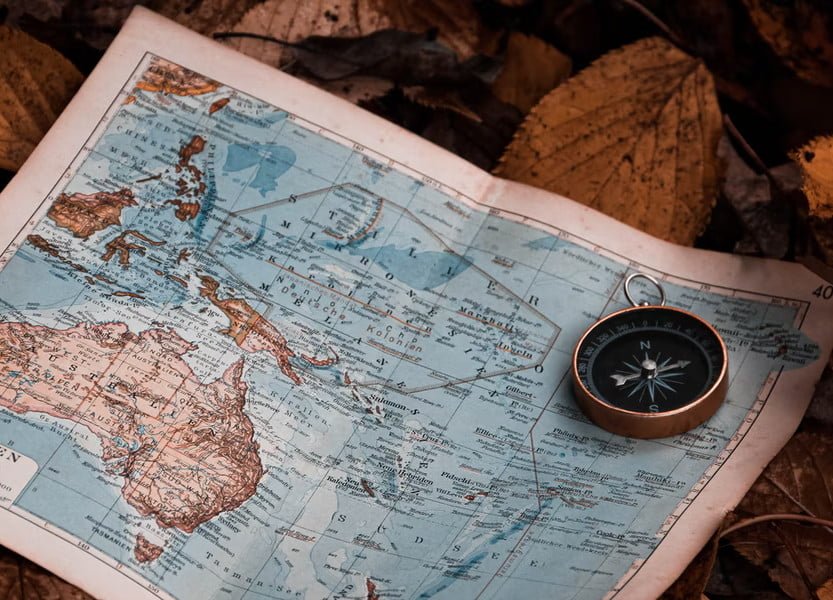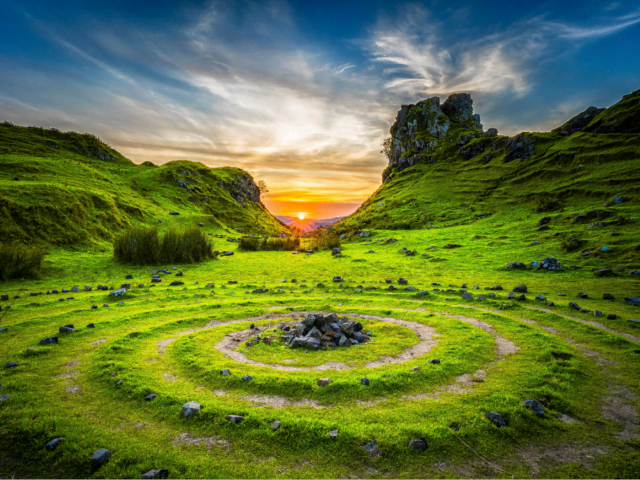Novelists of science-fiction or fantasy know worldbuilding is a huge part of the fun of writing, from magical medieval worlds to apocalyptic dystopias. There’s something wonderful about writing brave new worlds.
As George R.R. Martin has written:
We read fantasy to find the colors again, I think. To taste strong spices and hear the songs the sirens sang. There is something old and true in fantasy that speaks to something deep within us, to the child who dreamt that one day he would hunt the forests of the night, and feast beneath the hollow hills, and find a love to last forever somewhere south of Oz and north of Shangri-La. They can keep their heaven. When I die, I’d sooner go to middle Earth.
What’s described here just comes down to worldbuilding.
Whatever genre you’re in love with – historical fantasy, urban fantasy, hard or soft science-fiction, or something else – here are some general guidelines from us and an overview to consider.
Worldbuilding: Two Methods To Choose
M. John Harrison has defined worldbuilding as an ‘attempt to exhaustively survey a place that isn’t there’.
There are two established methods for science-fiction and fantasy, defined in The Kobold Guide to Worldbuilding. These are outside-in (otherwise called top-down) or inside-out (bottom-up) – so we’ll work with these definitions to help you sense which broad approach you prefer.
If you’re for outside-in, you’ll go with worldbuilding before just about anything else (i.e. plot, character, creatures) in your sci-fi or fantasy writing.
You’ll want that intricately-crafted world there in your mind, detailed in notes, ready for readers to explore as much as you yourself would wish to. Maybe you’ll need it complete with histories, languages and more – because you feel fantastical worlds need a sense and structure first for a story to operate in. Perhaps you’ll want to know every nook and cranny, creating mythologies, histories, etymologies surrounding your characters, like J.K. Rowling, or as J.R.R. Tolkien did when he created Middle Earth.
Tolkien, though, built The Hobbit around Bilbo Baggins – and then there came the history of Middle Earth and more. This makes Tolkien an inside-out world-builder. Bilbo, his character, came first and Middle Earth is built around Bilbo – all he must achieve, how he must grow – before Bilbo’s young cousin, Frodo, is forced to pick up Bilbo’s legacy in The Lord of the Rings and continue the journey. Similarly, the centre of J.K. Rowling’s series was always Harry himself.
With an inside-out approach, you’ll build worlds around characters, exploring as you go. This way is (arguably) most useful to you, helping you not get bogged down in the fun of worldbuilding.
You mustn’t ever neglect your story.
Mapping A New World
It’s not just a lot fun to create a world map. It’s worth doing even as a draft sketch for yourself, because the key rule to never break in worldbuilding is that your world must have an internal, underpinning logic to it. This helps convince us that no matter how fantastical your book material, it is authentic enough to feel plausible – enough for readers to buy into it all.
Think as you map mountains, savannahs, deserts – what do terrains mean for the societies you’ll create?
In fantasy epics, much of plot – including backstories, world histories and more – is tied up in mapping. The Iron Islands of A Song of Ice and Fire, as an example, are known for ironborn ships. Surrounded by seas, Iron Islanders depend upon their Iron Fleet. This doesn’t just sound imposing and impressive as a plot device from George R.R. Martin. It makes a certain logical sense that Iron Islanders would be dedicated to seafaring for their prosperity and survival.
There must be underpinning, internal rules to your world to create a due sense of realism, and this can feed into your plot arc, character journeys and all the rest.
As Jeff Vandermeer has written in Wonderbook:
Approaches to setting and character should be multidirectional: organic and three-dimension, with layers and depths. Throwaway settings are like throwaway characters: a missed opportunity.
These geographical elements are interconnected and worth exploring, researching carefully as a conscientious writer.
Mapping A Universe
If you’re building a planet for your science-fiction novel, or mapping star systems – all sorts of scientific questions begin to surface. That’s enough for a separate tome entirely.
Still, a quick note here to ‘hard sci-fi’ writers on its importance. Let’s say you were creating an alien planet with rings like Jupiter or Saturn. In terms of detail, some geological knowledge and understanding could help you in your descriptive writing.
Writer Stephen L. Gillett has written in his book World-Building how this planet would look:
Rings would make for spectacular skies … during the day, a vast white arch, probably visibly subdivided into concentric arcs, would stretch high across the southern sky, pallid but plainly visible. … As the sun set, the arch would blaze … like a lacework with its multiple interior arcs. Shepherd moons would appear like bright pearls. … As nightfall encroached … no stars at all would appear in the black band … [then] high in the east a brilliant arc would appear where the rings first caught the sunlight, and the brilliance would spread westward until the whole arch would glow just before dawn.
If you’re an enthusiast for science-fiction, learn to love the sciences, and read up on them. They could just offer new mines of inspiration. It’ll all take time, yes – and is it necessary?
It just depends.
Know how deep you wish to go. Know if your story (or you) may need it. It can’t hurt to consider, though.

Writing World Histories
Readers love exploring the histories of Westeros in A Song of Ice and Fire – the complex, horrific politics of King’s Landing. Readers become immersed in the stories of George R.R. Martin’s great families, forging uneasy alliances to retain positions of power. The books wouldn’t allure us if it weren’t for such details.
On the other hand, part of the suspense and unease of a novel like Margaret Atwood’s The Handmaid’s Tale stems from Offred’s patchy knowledge of her dystopia and its ambiguity.
A fairy-tale retelling like Uprooted by Naomi Novik strikes a middle ground. Some history is sketched for us but there’s no extensive mapping, no comprehensive history of intrigue. There’s still much mystery surrounding the Dragon, the ‘reaping’ faced by Agnieszka and Kasia, which can work to advantage in Uprooted. A little mystery is no bad thing.
However, to truly know your world, a world history or survey detailing just as much as you need to write would probably be useful. It’ll be useful material for you, yourself – no matter how much you share of it in your book. So that’s the most valid reason to create a world history – if you’ll enjoy making it, love writing it. Create notes, etchings for yourself. You needn’t create these with the intension to publish, either.
J.R.R. Tolkien wrote The Silmarillion, reams on the histories of Middle Earth, but never meant this book or others to be published. J.K. Rowling also kept detailed notes and sketches of Harry Potter’s world for years. All of it was meant for her reference and only after Harry’s success did she go on to reveal these on the website Pottermore, from supporting characters’ back stories to the intricacies and origins of wandlore, and more. Wherever stories catch on, a desire for more can often follow as George R.R. Martin also discovered before finishing his series. He published The World of Ice and Fire, an informative history ‘textbook’ for his world, detailing all that led up to events of A Game of Thrones.
Still, your world history is really your backdrop for readers. In one sense, you must ‘always leave them hungry’ because a world history is not the same thing as your story – and it’s the stories themselves that grip us. Better leave readers hungry then inundate too much and risk boring anyone. This said, a world history would still bear heavily upon your plot and any world history should feel organic, not tacked on. Your world history, at least as far as readers are concerned, needs to be fleshed out just enough as far as is relevant for the here and now of your plot and characters.
Writing Alternate Histories
Building alternate histories (i.e. reworking the histories of this world, recreating this world with intricately changed aspects), though, is another matter. A separate branch of worldbuilding, this is trickier, because you’ll need to research extensively before you rework. If certain events didn’t happen, how would this bear on your written worlds or societies?
Susanna Clarke’s Jonathan Strange and Mr Norrell is an example of how to write an alternative history well. Set in Regency England with magicians thrown in, the myth of the Raven King casts a shadow over all as magic ‘returns’ to England, as London society is dazzled by spells and ladies raised from the dead. The entire novel is punctuated with long (optional) footnotes and backstories, making for a deftly and thoroughly researched world of alternative history.
In this sense, you can take inspiration from real-life histories – in A Song of Ice and Fire, civil war ensues following the beheading of key protagonist Eddard Stark – but anyone who’s read The Accursed Kings by Maurice Druon (on the collapse of the French Capetian Dynasty) will see some parallels in A Song of Ice and Fire.
Don’t be afraid of tapping into history, however extensively, to inform your own worldbuilding.
Creating Magical Societies
If you’re writing a fantastical society with some magic (as so often will be the case), what are your magic’s rules and limitations? Harry Potter’s magical universe is held together by rules. A curse can be met with a counter-curse. Servile creatures like house-elves have secret powers that Voldemort, who wants to be invincible, spurns to his cost. Are there cults (religious or not), guilds or secret societies, like the Order of the Phoenix created to battle Voldemort?
Also, how will it affect your protagonist if he or she isn’t using magic in a magical world? Are they afraid of it? In children’s series The Song of the Lioness by Tamora Pierce, Alanna and Thom are twins sent away from home. Protagonist Alanna is to go north and learn magic (as ladies do in her world). Thom is to become a knight, and neither wants their fate. In secret, Thom travels north – both boys and girls can learn magic – but Alanna becomes ‘Alan’, disguises herself a boy, and learns to fight. Alanna isn’t drawn to magic (synonymous with power in these stories), as her brother is. She finds she must still use her magic to help defend Tortall as she grows older.
If you’re creating religions, too, will these be monotheistic or polytheistic? In George R.R. Martin’s A Song of Ice and Fire, different gods are worshipped – with consequences. Arya Stark joins a cult worshipping the ‘Many-faced God’ or ‘God of Death’ to become an assassin. Melisandre is a prophetess carrying religion to catastrophic extremes. In The Song of the Lioness, however, it is a Goddess worshipped. She’s able to appear to protagonist Alanna as a tangible being, appealing to Alanna’s inner life and journey at a deeply personal level.
So how will your story’s religion affect things, if you’re writing one? This can’t be a throwaway topic, just as there can’t be throwaway settings or people.
Everything, no matter how much you create, how big or small the details, should remain significant.
Creating Dystopias
Dystopian societies are (arguably) on trend in writing right now. Dystopia has long been established as a ‘soft’ sci-fi subgenre, as have fantasy novels. Writing dystopian societies whilst keeping details rich, and characters human despite their loathsomeness, can be tricky.
In The Handmaid’s Tale, for instance, ‘criminals’ targeted are hanged in public to control, to crush subversion. Handmaids like Offred lose their names in Gilead, so Gilead also makes the spread of information impossible. Margaret Atwood’s setup is clever and it makes revolution seem a distant dream – it’s impossible to rebel if you can’t pull together accurate enough information. As an example, Offred meets her companion, Ofglen, one day, only to find a different Ofglen waiting. Her Ofglen has been replaced. In the novel, Offred is left to believe Ofglen hanged herself before a van could arrive and take her away. Names, identities, information, are lost as another tool of this repressive society.
Even in Gilead, though, nothing is black and white. Offred’s Commander helps uphold a sick regime. Yet even he is nostalgic for the past – offering Offred a secret night out, bribing her with Scrabble game matches, old magazines – outlawed under Gilead.
So keep your storytelling, characters and worldbuilding complex, even (or especially) where it’s tempting to paint the world in black and world.
Releasing Information
If you inundate readers too much on ‘world material’, it could risk being a ‘turn-off’. So often a novel works because of a delicate control of information, i.e. you reveal more as you write, more as we read. Authors like J.R.R. Tolkien know this. He released information to his readers and to Frodo over time, just as J.K. Rowling does for Harry, etc., etc.
Meanwhile, Samantha Shannon, author of fantastical dystopia The Bone Season, has written on building heroine Paige Mahoney’s world of clairvoyants and the Rephaim, as well as writing about releases of information. How do you reveal a complex world without launching into fully-fledged history?
Samantha’s blog post reads:
After several attempts at an opening, I finally decided that it was worth setting aside a few pages in the early chapters to explain some key aspects of the world – spirit combat, the London gangs, Edward VII, dreamwalking and so on – before the story got going. In the long run, I knew this would save me time and stop me having to drop in this information in later chapters. It would also, critically, allow a reader to grasp the bare bones of the world before I started fleshing it out – at the risk of making them feel like they were being ‘talked at’. It was a fairly big risk and I know it won’t work for everyone, but I’d rather a reader knew too much than too little.
So just remember to bear in mind ‘story view’, as a narrator – how much do your readers need to know at this moment? Will it serve the plot?
Think where and how you’ll connect the dots over your novel.
An End Is Just A Beginning
These are the pointers, the foundations of all you need to think about.
Sketch and map out the details of your world, and if you need, create a collage (or a Pinterest board) of ideas and images to spark inspiration.
Most importantly – have fun, and happy writing!
Jericho Writers is a global membership group for writers, providing everything you need to get published. Keep up with our news, membership offers, and updates by signing up to our newsletter. For more writing articles, take a look at our blog page.











